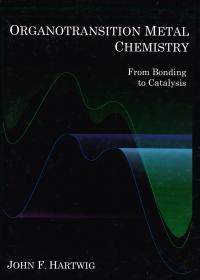Organotransition Metal Chemistry
Organotransition Metal Chemistry
By: John F. Hartwig
This book provides a thorough and authoritative coverage of the fundamentals of organometallic chemistry, the elementary reactions of these complexes, and many catalytic processes occurring through organometallic intermediates.
For all sales outside of the United States, please contact Felicity Henson, fhenson@aip.org
Title information
Organotransition Metal Chemistry – From Bonding to Catalysis provides a selective, but thorough and authoritative coverage of the fundamentals of organometallic chemistry, the elementary reactions of these complexes, and many catalytic processes occurring through organometallic intermediates. Built upon the foundation established by the classic text by Collman, Hegedus, Norton and Finke, this text consists of new or thoroughly updated and restructured chapters and provides an in-depth view into mechanism, reaction scope, and applications.
The early chapters describe the principles of bonding and the classes of ligands that characterize organotransition metal chemistry. The remainder of the book focuses on the reactions of organometallic complexes. The second portion of the book describes the classic stoichiometric organometallic reactions, including ligand substitution, oxidative addition, reductive elimination, migratory insertions, eliminations, electrophilic attack on coordinated ligands, nucleophilic attack on coordinated ligands, and chemistry of metal-ligand multiple bonds. The third portion of the text describes the principles of catalysis and the classic catalytic processes of organometallic systems. Written by a teacher and experienced practitioner of the field, the book’s content is simultaneously accessible to students with no background in the subject matter and invaluable to synthetic organic chemists, inorganic chemists, and even experts in the field.
Translated into Japanese.
Chapter 1
Structure and Bonding
Chapter 2
Dative Ligands
Chapter 3
Covalent Ligands Bound Through Metal-Carbon and Metal-Hydride Bonds
Chapter 4
Covalent Ligands Bound Through Metal-Heteroatom Bonds
Chapter 5
Ligand Substitution Reactions
Chapter 6
Oxidative Addition of Non-Polar Reagents
Chapter 7
Oxidative Addition of Polar Reagents
Chapter 8
Reductive Elimination
Chapter 9
Migratory Insertion
Chapter 10
Elimination Reactions
Chapter 11
Nucleophilic Attack on Coordinated Ligands
Chapter 12
Electrophilic Attack on Coordinated Ligands
Chapter 13
Metal-Ligand Multiple Bonds
Chapter 14
Principles of Catalysis
Chapter 15
Homogenous Hydrogenation
Chapter 16
Hydrofunctionalization and Oxidative Functionalization of Olefins
Chapter 17
Catalytic Carbonylation
Chapter 18
Catalytic C-H Functionalization
Chapter 19
Cross Coupling
Chapter 20
Allylic Substitution
Chapter 21
Catalytic Metathesis of Olefins and Alkynes
Chapter 22
Olefin Polymerization
|
“Educating students thoroughly in organometallic chemistry is difficult…For the most part, I tell my students “With great coverage of all aspects of the field, Hartwig’s Organotransition Metal Chemistry: From Bonding to Catalysis is the new must-have text that very soon will be recognized far and wide as a true chemistry classic.” “This outstanding book provides comprehensive coverage of modern topics in organometallic chemistry. It is a treasure trove of information that will prove invaluable for both students and practitioners of the field.” “The most notable applications of organometallic chemistry in the past two decades have been characterized by the use of fundamental aspects of structure, bonding and reactivity. To anyone who wants to engage in this line of research, this text will serve as the single best source for all the essential information.” “A very useful reference work.” “This long-awaited text does a fine job of covering the most important developments in organotransition metal chemistry over the last 20 years, while retaining the earlier versions’ effective presentations of basic concepts and older work. It should well serve both teachers choosing a textbook for an advanced course and active researchers looking for a good starting reference source.” |
John F. Hartwig
John F. Hartwig is the Henry Rapoport Chair in Organic Chemistry and Professor of Chemistry at the University of California, Berkeley. Professor Hartwig received his A. B. degree from Princeton and his Ph.D. from the University of California, Berkeley. Subsequently, he was an American Cancer Society Postdoctoral Fellow at the Massachusetts Institute of Technology, joined the Yale University faculty in 1992, and joined the University of Illinois chemistry faculty in July 2006. Professor Hartwig’s research focuses on the discovery and mechanistic understanding of organic reactions catalyzed by organometallic complexes. He was one of the originators of palladium-catalyzed cross-coupling reactions to form carbon-heteroatom bonds, as well as palladium-catalyzed coupling of enolates and catalytic functionalization of the terminal C-H bonds in alkanes. He was elected as a member of the National Academy of Sciences in 2012, was the recipient of the 2008 Mukaiyama Award from the Society of Synthetic Organic Chemistry, Japan, the 2008 International Catalysis Award from the International Association of Catalysis Societies, the 2008 Paul N. Rylander Award of the Organic Reactions Catalysis Society, the 2007 Tetrahedron Young Investigator Award in Organic Synthesis, the 2007 Raymond and Beverly Sackler Prize in the Physical Sciences, and the 2006 ACS Award in Organometallic Chemistry.

